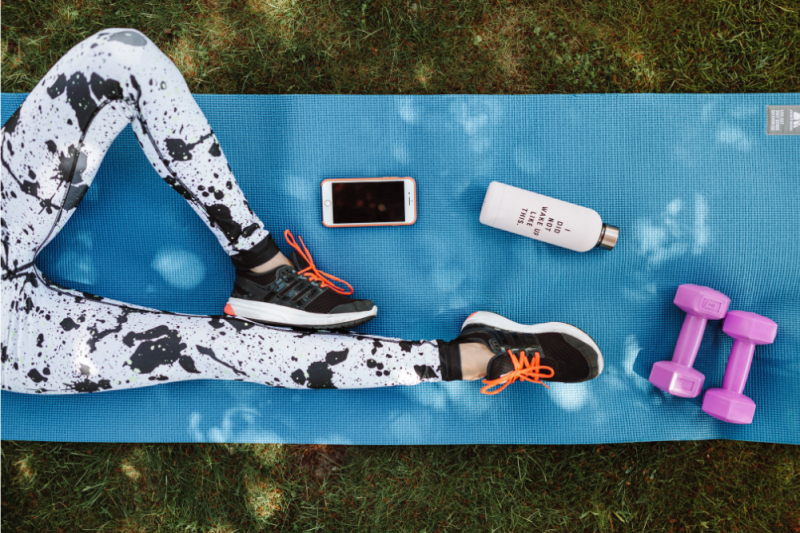HIIT at home
Elite athletes and coaches have long known about the benefits of high-intensity interval training (HIIT) and they have been reaping the rewards, too. The formal coaching term refers to alternating periods of short, intense anaerobic exercise with a less intense recovery period. The idea behind HIIT is simple: by moving the body with intent, you can see big results in less time.
HIIT training is well known as the fastest way to build muscle, increase aerobic fitness and improve weight loss capabilities. The key measure for HIIT is extending beyond your comfort zone and feeling your body.
The most productive length of a HIIT workout is less than 30 minutes and it should alternate between maximum effort for a period of 15 to 30 seconds and shorter recovery sets of lower intensity. These bursts of increased energy intensify and increase the rate of caloric expenditure, meaning that more calories are burned, which ensures better body composition and mobility.
An added bonus of a HIIT workout is the body continues to burn calories for two hours afterwards. This benefit is the result of the excess post-exercise oxygen consumption (EPOC) as the body returns to homeostasis after exercise. With HIIT, the total calories burned are greater in EPOC than any type of continuous exercise or endurance activity.
Another advantage of HIIT is it can be customised to any fitness program. HIIT can be applied to almost any type of workout, including a morning walk, running, cycling or a gym strength set. HIIT is more enjoyable than low-intensity, steady state exercise, which means people are more likely to stick to the vigorous program. It boosts your body faster by improving endurance.
The most important component, though, is that HIIT is time-efficient. It achieves the same results, if not greater results, in half the time of any lower-intensity or longer-duration workout sessions.
However, there are some tricks to creating the right program that will not cause injury or excess fatigue. To improve or encourage your HIIT performance, try these tips and tricks.
- Set a timer.
- Turn up the tunes and work with the beat of the music.
- Complete a warm-up and cool-down walk.
- Eat one hour before the activity (you’ll not only have noticeably increased performance, but you’re also less likely to feel sick and off-balance as your body scrambles for energy for the higher-intensity parts).
- Make sure intervals are not too long; they should last 15 to 30 seconds. During HIIT, the objective is to go as hard and as fast as you can during work intervals. You’ve got a small window of time to do so before hitting fatigue or failure.
- Ensure form and alignment are right. This is one of the most frequent HIIT mistakes, as this style of workout is intense and takes a big burst of energy and effort. Poor form can put strain on the joints and work the wrong-targeted muscle groups, which makes the body susceptible to injury.
- Do not rest too long between sets, as the heart rate needs to stay higher than a cardio rate. It is important to make sure that you are staying strict with small breaks to bring your heart rate down in between exercises.
- Ensure the weight is not too heavy, as the important part is getting that heart rate up. The goal of performing high-intensity intervals is to increase strength, so choose a weight where you can complete 15 to 25 reps before failure. When in doubt, start light. You can always go faster and bump up the weights.
HIIT is meant to be really intense and hard, hence the name. Beginners often find “the intensity” difficult, but pushing outside of your comfort zone is the key.
Follow the most important rule of HIIT: push as hard as you can until the rest period. You may even find this HIIT addiction will convert into your chores list — try a HIIT declutter and cleaning day!
HIIT home workout
- Equipment: 5kg hand weights, gym mat and an optional 8kg kettle bell.
- Set the timer: One minute per exercise, 10 minutes per set and rest.
- Complete the first set with alignment.
- Complete the second set as fast as possible.
- Complete the last set to maximum speed and max out on all repetitions.
- The repetitions are base level — go to your maximum.
- If you cannot jump due to any prior injury, replace with a step and pause technique in the beginning and final position.
24 × Speed step-ups
12 × Caterpillar plank rows
24 × Back-step lunges
12 × Sumo squat jumps
24 × Single leg step-downs with hop top
12 × Kettle bell sumo squats
24 × Plank runners
12 × Sit-ups with 5kg weight








